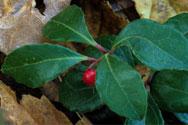
Photo © Steven Foster
Introduction
Wintergreen is a perennial that grows to 5 or 6 inches with white drooping flowers in June and July followed by bright red berries.1,2 Native to the eastern portion of North America, wintergreen is found from Canada, Newfoundland, and Minnesota to Georgia and Alabama.2,3 The oil is extracted from the leaves, but the berries and remaining portions of the plant are used as well.4 History and Cultural Significance
Oil of wintergreen contains methyl salicylate which has anti-inflammatory properties and is closely related to the well-known medication aspirin.5 Wintergreen and the oil of wintergreen are used in topical pain relievers and products that produce a feeling of warmth for muscle and rheumatic pain relief.4,6 Oil of wintergreen has also been used for the treatment of cellulitis, a bacterial infection accompanied by inflammation of the skin.5 In the past, wintergreen was used internally to treat chronic mucous discharges, regulate hormones, and as a diuretic; due to its toxicity it is no longer used internally for medicinal purposes.1 Wintergreen is commonly used in very small amounts to adjust the flavor in candies, chewing gum, herbal teas, mouthwashes, toothpastes, and various beverages.2,4 It is also found in insect repellents and insecticidal products.2 North American Indians chewed the leaves of the wintergreen plant for their distinct flavor, used them in the treatment of aches and pains, and to aid in breathing during hard work.3,5 French explorers used wintergreen leaves in hot infusions, thus leading to the term ‘Thé du Canada’, the tea of Canada.3 During the American war of independence, wintergreen leaves served as a replacement for Chinese tea.3 Folk remedies also used the wintergreen plant for body aches, cold symptoms, colic, headaches, inflammation, pain, skin diseases, sore throats, rheumatism, and tooth decay.2,4 Modern Research
No current documented studies are available on the external or internal uses of wintergreen or wintergreen oil. However, methyl salicylate is tentatively is accepted by the U.S. Food and Drug Administration as an over-the-counter (OTC) external analgesic, and it is included in many OTC products intended to relieve mild muscle and joint pain. There are current studies on the active constituent of wintergreen, methyl salicylate, for use in topical creams in the treatment of pain relief, possible antimicrobial use in dental care, and the comparison of salicylate levels between the oil of wintergreen and synthetic methyl salicylate cream.7,8,9 Future Outlook
Wintergreen oil production is on the decline due to the production of its replacement, synthetic methyl salicylate.10 Although the natural oil of wintergreen is available and in use by some manufacturers, it is very rare and most of what is labeled wintergreen oil on the market is actually synthetic methyl salicylate.11 References
1 Grieve M. A Modern Herbal. Volume II. New York: Dover Publications, 1981. 2 Wintergreen. Purdue University Center for New Crops and Plant Products website. December 6, 1997. Available at: http://www.hort.purdue.edu/newcrop/med-aro/factsheets/WINTERGREEN.html. Accessed October 6, 2004. 3 Guenther E. The Essential Oils. Volume VI. Huntington, NY: Robert E. Krieger Publishing Company, 1952. 4 DerMarderosian A, Beutler JA (editors). The Review of Natural Products: The Most Complete Source of Natural Product Information. 3rd edition. St. Louis, Mo: Facts and Comparisons, 2002. 5 Plants for a Future: Database Search Results: Gaultheria procumbens. ibiblio website. Available at: http://www.ibiblio.org/pfaf/cgi-bin/arr_html?Gaultheria+procumbens. Accessed October 6, 2004. 6 Williamson EM. Potter’s Herbal Cyclopaedia. Saffron Walden, UK: C.W. Daniel Company, 2003. 7 Lobo SL, Mehta N, Forgione AG, et al. Use of Theraflex-TMJ topical cream for the treatment of temporomandibular joint and muscle pain. Cranio. April 2004;22(2):137-144. 8 Charles CH, Vincent JW, Borycheski L, et al. Effect of an essential oil-containing dentifrice on dental plaque microbial composition. Am J Dent. September 2000;13:26C-30C. 9 Wolowich WR, Hadley CM, Kelley MT, Walson PD, and Casavant MJ. Plasma salicylate from methyl salicylate cream compared to oil of wintergreen. J Toxicol Clin Toxicol. 2003;41(4):355-358. 10 Arctander S. Perfume and Flavor Materials of Natural Origin. Carol Stream , IL: Allured Publishing Corporation, 1994. 11 Tisserand R, Balacs T. Essential Oil Safety: A Guide for Health Care Professionals. New York: Churchill Livingstone, 1995.
|